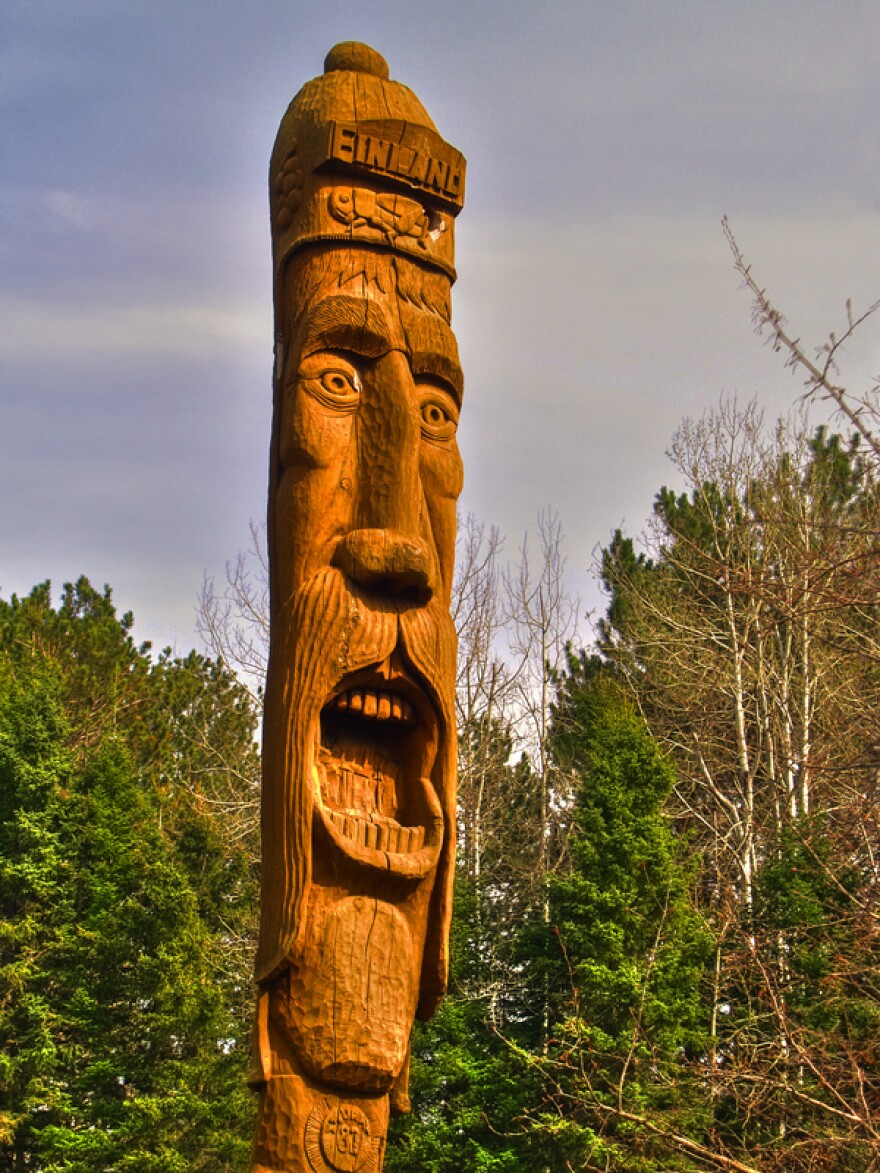Alvin Kangas was pretty excited to have acquired a 16 pound buffalo fish in time to make a kettle of his fish head stew for this year’s St Urho’s Day celebration in Lake Norden.
Every year in small towns in Minnesota, and a couple in South Dakota, people of Finnish descent don purple, or pick up a pitchfork, to celebrate the mythical saint chased the grasshoppers out of Finland.
Does this story sound vaguely familiar? That’s kind of the point. The origins of St. Urho’s Day are somewhat mysterious, but its purpose is simple.
On the question of how it began: There’s the Sulo Havumaki camp, who claim that the Bemidji State University professor invented the holiday. Others credit Richard Mattson, a long-time department store manager in Virginia, Minnesota. Still others claim it was a collective invention of Finnish workers in the iron ore mines of Northern Minnesota. At the post-parade St. Urho's Day potluck in Lake Norden on Saturday, team Havumaki had the majority.

Beyond the how, there’s a near universal consensus, within the small universe of people who have heard of St. Urho, on the why. The Irish had a day. Why not the Finns?
So sometime in the 1950’s, somebody — maybe Mattson or Havumaki — concocted a transparently derivative myth in which a purple-clad saint in a Viking-style helmet, armed with a pitchfork, saved Finland’s vineyards from a scourge of grasshoppers with the magic words: Heinasirkka, heinasirkka, mene talta hiiten (Grasshopper, grasshopper, go away.)
That Finland's climate is not all that amenable to grape cultivation makes perfect sense.
Everything about St. Urho's Day is a transparent mashup, obvious ripoff, or happy absurdity. It's as if a people were envious of another people's Superman, decided to invent their own, then at the last minute chose Zan from the Wonder Twins instead.
Like, were we not supposed to notice that the Saint just happens to share a name with Urho Kaleva Kekkonen, who just happened to serve as Finnish Prime Minister right around the time St. Urho’s Day was born? It’s an unabashedly tongue-in-cheek holiday that deflates with a rusty pitchfork the sincerity we assign to certain days. In some localities, it's a day half-planned but not expected to actually happen. According to legend Sulo Havumaki himself would often announce the Bemidji parade only to cancel when nobody showed up.

Some towns are serious (kind of) about St. Urho's Day, by Urholian standards. Finland (go figure) and Menagha, Minnesota have handsome statuary dedicated to the Saint.

Lake Norden — one of a couple Finn-Centric South Dakota towns (Frederick is another) that honor the day — started their St. Urho tradition with a single pickup “parade” in 1979. Over the years, the Lake Norden celebration has grown into… well, into a small town procession of a few vehicles — one conveying the king and queen in purple regalia and horned helmet — maybe a tractor with Finnish and American flags, then a candy toss for the kids. The Day officially falls on March 16 (to stay a day ahead of the snake chaser). "But we usually celebrate on the Saturday after,” says Kangas, a parade organizer, “just because it’s a few more days into spring, so maybe we have warmer weather.”
Alvin Kangas is as Lake Norden Finn as it gets, as Finn as the fish head soup he brought to the potluck. “All four of my great grandfathers homesteaded within eight miles of where I live. So I’ve always felt that if the old guys came all the way from Finland and thought this was a good place to live, it was good enough for me.”
After the parade, there’s the potluck at the Lake Norden Community Center with Marie Koistinen’s kalamojakka (fish soup), Finnish style meat balls and flat bread, and a fruit soup with apricots, raisins and prunes.

This year, Ron Kangas (Alvin’s second cousin) read from the “Finnglish” prose of Kool Kat From Kopper Kontri author Heino “Hap” Puotinen. Sauna (pronounced sow-na) is a common theme in Puotinen’s work — and a staple of Finnish culture. Some Lake Nordeners still have wood stove heated saunas. The tale Ron read Saturday was a comical take on an Americanization of the vasta tradition, a switch used for self-whipping in the sauna. This is not punitive self-flagellation. Kept cool, the vasta is meant to refresh and invigorate in the hot sauna. In Finland the vasta is usually made of birch twigs but in South Dakota cottonwood will do.
After Ron's readings, Alvin passed the microphone around to anybody who wanted to share a tale of St. Urho's Days past or memories of sauna shenanigans.
Then people just kind of filed out into the blustery day.
“Many years ago," says Alvin, "the pastor [at Trinity Lutheran in Lake Norden] summed up our St. Urho activities like this: it’s a whole bunch of nothing to get excited about.”

